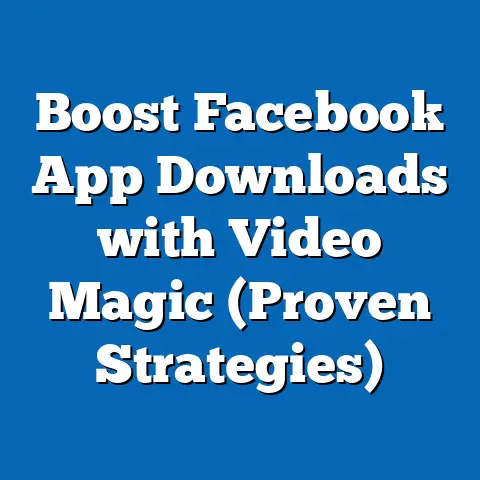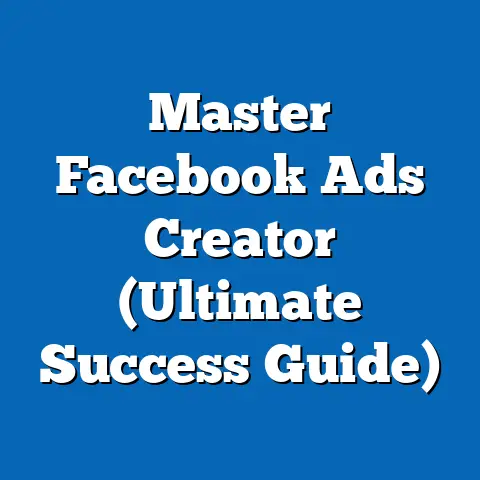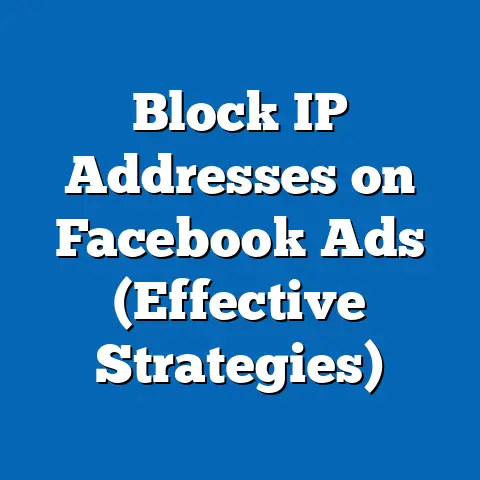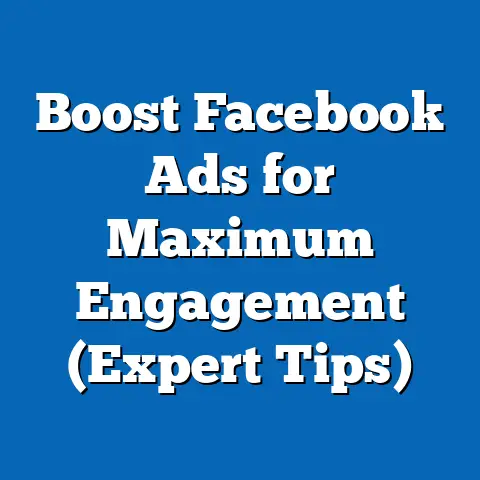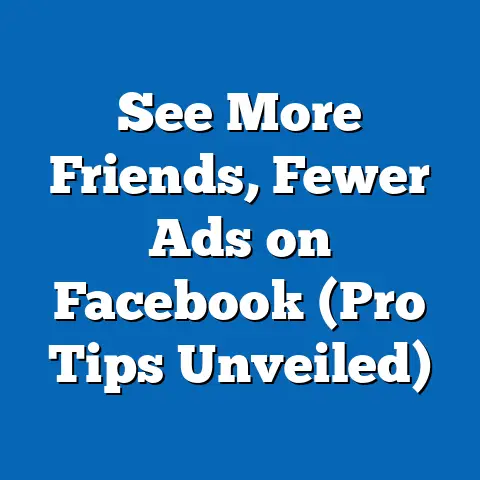Maximize Engagement with Facebook Overlay Ads (Pro Tips)
Nostalgia. It’s a powerful force, isn’t it? Think about it: the comforting scent of your grandmother’s baking, the catchy tune of a childhood cartoon, the thrill of rediscovering a vintage video game. These sensory experiences instantly transport us back to simpler times, evoking feelings of warmth, happiness, and connection. And believe me, as a digital marketing specialist with years of experience running Facebook ad campaigns, I’ve learned that tapping into this emotional wellspring can be a game-changer for your advertising efforts.
I remember working with a local bakery a few years ago. Their Facebook ads were getting lost in the noise, just like everyone else’s. Then, we decided to go for a nostalgic campaign. We featured images of their original storefront from the 1950s, alongside photos of their classic recipes, like their famous apple pie. The response was incredible! People were commenting, sharing stories about their own memories of the bakery, and, most importantly, flooding the store to buy those pies. That’s when I truly understood the power of nostalgia in advertising.
Why does nostalgia work so well? It’s simple: it creates an instant connection. In a world saturated with generic ads and fleeting trends, nostalgic content stands out because it feels authentic and personal. It evokes emotions, builds trust, and makes your brand more relatable.
Now, let’s talk about Facebook Overlay Ads. In the crowded digital landscape, grabbing attention is half the battle. Facebook Overlay Ads, when done right, are your secret weapon. They’re designed to stand out, to interrupt the endless scroll, and to captivate your audience. And when you combine the attention-grabbing power of Overlay Ads with the emotional pull of nostalgia, you’ve got a recipe for advertising success.
Section 1: Understanding Facebook Overlay Ads
Let’s start with the basics. What exactly are Facebook Overlay Ads, and how do they fit into the broader Facebook advertising ecosystem?
What are Facebook Overlay Ads?
Facebook Overlay Ads are ad formats that appear directly on top of existing content, like videos or images, within a user’s Facebook feed or Stories. Think of them as dynamic additions that enhance the viewing experience while delivering your marketing message. Unlike standard ads that appear as separate posts in the feed, Overlay Ads are integrated seamlessly into the existing content, making them less intrusive and often more engaging.
Overlay Ads vs. Standard Ads:
The key difference between Overlay Ads and standard Facebook ads lies in their placement and presentation. Standard ads appear as standalone posts, blending in (or trying to) with organic content. Overlay Ads, on the other hand, are designed to grab attention by appearing directly on top of content that users are already viewing. This can lead to higher visibility and engagement, as users are more likely to notice and interact with an ad that’s integrated into their viewing experience.
Mechanics of Overlay Ads:
Overlay Ads are typically used with video content, but they can also be applied to images. Here’s a breakdown of the mechanics:
- Placement Options: You can choose where the overlay appears – at the top, bottom, or even dynamically throughout the video. The placement should complement the video content and not obstruct important visuals.
- Formats: Facebook offers various formats for Overlay Ads, including:
- Text Overlays: Simple text messages that appear on top of the video.
- Image Overlays: Small images or logos that are placed on the video.
- Call-to-Action Overlays: Buttons that encourage viewers to take a specific action, like “Shop Now” or “Learn More.”
- Carousel Overlays: A series of images or videos that viewers can swipe through while watching the main video.
- Canvas Overlays: Full-screen interactive experiences that open when a user clicks on the overlay.
- User Experience: The user experience is crucial. Overlay Ads should be non-disruptive and easy to dismiss. They should add value to the viewing experience, rather than detract from it.
- Text Overlays: Simple text messages that appear on top of the video.
- Image Overlays: Small images or logos that are placed on the video.
- Call-to-Action Overlays: Buttons that encourage viewers to take a specific action, like “Shop Now” or “Learn More.”
- Carousel Overlays: A series of images or videos that viewers can swipe through while watching the main video.
- Canvas Overlays: Full-screen interactive experiences that open when a user clicks on the overlay.
Advantages of Using Overlay Ads:
In my experience, Overlay Ads offer several distinct advantages:
- Higher Visibility: By appearing directly on top of content, they’re harder to miss than standard ads.
- Increased Engagement: The dynamic nature of Overlay Ads encourages interaction, leading to higher click-through rates and conversions.
- Seamless Integration: They blend into the viewing experience, making them less intrusive and more appealing to users.
- Creative Flexibility: You have a wide range of options for designing and implementing Overlay Ads, allowing you to tailor them to your specific marketing goals.
Statistics and Case Studies:
The proof, as they say, is in the pudding. Here are some compelling statistics and case studies that highlight the effectiveness of Overlay Ads:
- Increased Click-Through Rates: Studies have shown that Overlay Ads can increase click-through rates by as much as 20% compared to standard ads.
- Improved Brand Recall: Overlay Ads can improve brand recall by up to 15%, as they create a more memorable and engaging viewing experience.
- Case Study: E-commerce Brand: An e-commerce brand used Carousel Overlay Ads to showcase multiple products while users watched a demonstration video. This resulted in a 30% increase in product page visits and a 15% increase in sales.
- Case Study: Mobile Game Developer: A mobile game developer used Call-to-Action Overlay Ads to encourage users to download their game while watching gameplay videos. This led to a 25% increase in app downloads.
Takeaway: Facebook Overlay Ads are a powerful tool for capturing attention, driving engagement, and achieving your marketing goals. By understanding the mechanics and advantages of Overlay Ads, you can start to incorporate them into your advertising strategy and see real results.
Next Steps: Explore the different formats and placement options available for Facebook Overlay Ads. Consider how you can use them to enhance your existing video and image content.
Section 2: Crafting Compelling Nostalgic Content
Now that we understand the power of Facebook Overlay Ads, let’s talk about the content that goes inside them. And that’s where nostalgia comes in. But how do you create nostalgic content that resonates with your audience?
Know Your Audience:
The first step is to deeply understand your target audience. What were their formative years like? What music did they listen to? What movies did they watch? What trends did they follow? The more you know about their past, the better you can tailor your nostalgic content to their specific interests and preferences.
For instance, if you’re targeting millennials, you might incorporate elements from the 1990s, like vintage video game consoles, classic cartoon characters, or iconic fashion trends. If you’re targeting baby boomers, you might focus on the 1960s and 1970s, featuring classic rock music, vintage cars, or images of historical events.
Incorporating Elements from the Past:
Once you know your audience, you can start incorporating elements from the past into your ad content. Here are some ideas:
- Vintage Graphics: Use old-fashioned fonts, retro color schemes, and vintage illustrations to create a nostalgic visual appeal.
- Classic Music: Incorporate popular songs from the past into your video ads. Music has a powerful ability to evoke memories and emotions.
- Throwback Themes: Create ads that are themed around a specific decade or era. For example, you could create a 1980s-themed ad with neon colors, synth music, and references to popular movies like “Back to the Future.”
- Historical References: Use images or footage of historical events, landmarks, or cultural icons to create a sense of nostalgia and connection.
Successful Brands Using Nostalgia:
Many brands have successfully utilized nostalgia in their Facebook Overlay Ads. Here are a few examples:
- Coca-Cola: Coca-Cola is a master of nostalgic advertising. They often feature vintage ads, classic logos, and images of their iconic bottles to evoke feelings of warmth and happiness.
- Nintendo: Nintendo has successfully tapped into nostalgia by re-releasing classic video game consoles and featuring retro games in their ads.
- Old Spice: Old Spice has revitalized its brand by embracing its heritage and using humor to create ads that appeal to both older and younger audiences.
Balancing Nostalgia and Relevance:
It’s important to strike a balance between nostalgia and relevance. Your content should evoke feelings of nostalgia, but it should also be relevant to your brand and your target audience. You don’t want to alienate younger audiences by focusing too much on the past.
One way to achieve this balance is to incorporate nostalgic elements into your ads while also highlighting the modern benefits of your product or service. For example, you could create an ad that features a vintage car alongside a modern smartphone, highlighting the contrast between the past and the present.
Takeaway: Crafting compelling nostalgic content requires a deep understanding of your audience, a creative approach to incorporating elements from the past, and a careful balance between nostalgia and relevance.
Next Steps: Research your target audience’s past and brainstorm ideas for incorporating nostalgic elements into your Facebook Overlay Ads.
Section 3: Design Best Practices for Overlay Ads
Now, let’s move on to the visual aspect of your Overlay Ads. Design plays a crucial role in capturing attention and conveying your message effectively.
Design Principles for Visual Appeal:
Here are some design principles to keep in mind when creating your Facebook Overlay Ads:
- Color Schemes: Use color schemes that evoke nostalgia. Retro color palettes often include warm, muted tones like browns, oranges, and yellows.
- Typography: Choose fonts that are reminiscent of the past. Vintage fonts can add a touch of authenticity and nostalgia to your ads.
- Imagery: Use high-quality images that are relevant to your nostalgic theme. Vintage photographs, illustrations, and graphics can help to create a sense of connection.
- Simplicity: Keep your design clean and simple. Avoid cluttering your ad with too many elements.
- Contrast: Use contrast to make your text and images stand out.
- Call to Action: Make your call to action clear and prominent.
Checklist for Visually Captivating Overlay Ads:
Here’s a checklist to help you create visually captivating Overlay Ads:
- Recommended Dimensions: Follow Facebook’s recommended dimensions for Overlay Ads.
- Aspect Ratios: Use appropriate aspect ratios for your images and videos.
- Design Tools: Use professional design tools like Adobe Photoshop or Canva to create high-quality graphics.
- Branding: Maintain brand consistency by using your brand colors, fonts, and logos.
- Nostalgic Elements: Incorporate vintage graphics, classic music, or throwback themes.
- Call to Action: Include a clear and compelling call to action.
- Mobile-Friendly: Ensure that your ad looks good on mobile devices.
Maintaining Brand Consistency:
While it’s important to leverage nostalgic elements in your design, it’s also crucial to maintain brand consistency. Your Overlay Ads should still reflect your brand’s identity and values.
One way to achieve this balance is to use your brand colors and fonts in your nostalgic design. You can also incorporate your logo into your ad to reinforce brand recognition.
Examples of Well-Designed Overlay Ads:
Here are some examples of well-designed Overlay Ads that successfully combine nostalgia with brand identity:
- A clothing brand uses vintage-inspired patterns and colors in their Overlay Ads to promote their new collection.
- A food company features classic recipes from the past in their Overlay Ads to evoke feelings of comfort and nostalgia.
- A technology company uses retro graphics and sound effects in their Overlay Ads to promote their latest product.
Takeaway: Design is a critical element of Facebook Overlay Ads. By following design best practices and maintaining brand consistency, you can create visually captivating ads that capture attention and drive engagement.
Next Steps: Experiment with different design elements and tools to create visually appealing Overlay Ads that evoke nostalgia and reinforce your brand identity.
Section 4: Targeting and Audience Segmentation
Creating great content is only half the battle. You need to make sure your ads are seen by the right people. That’s where targeting and audience segmentation come in.
Importance of Audience Targeting:
Audience targeting is the process of identifying and selecting the specific group of people who are most likely to be interested in your product or service. By targeting your ads to the right audience, you can increase your chances of achieving your marketing goals.
On Facebook, audience targeting is crucial because it allows you to reach a massive audience with incredible precision. You can target people based on their demographics, interests, behaviors, and more.
Facebook Targeting Options:
Here are some of the targeting options available on Facebook:
- Demographics: You can target people based on their age, gender, location, education, and other demographic factors.
- Interests: You can target people based on their interests, hobbies, and passions.
- Behaviors: You can target people based on their online behavior, such as their purchase history, their website visits, and their app usage.
- Custom Audiences: You can create custom audiences based on your own data, such as your email list or your website visitors.
- Lookalike Audiences: You can create lookalike audiences based on your existing customers or website visitors.
Tailoring Nostalgic Content for Different Segments:
When using nostalgic content, it’s especially important to tailor your message to different audience segments. What resonates with one group may not resonate with another.
For example, if you’re targeting millennials, you might focus on the 1990s and early 2000s. If you’re targeting Gen X, you might focus on the 1970s and 1980s. And if you’re targeting baby boomers, you might focus on the 1950s and 1960s.
Case Studies:
Here are some case studies highlighting brands that have succeeded in targeting specific audiences with nostalgic Overlay Ads:
- A movie studio targeted fans of classic horror movies with Overlay Ads featuring vintage posters and trailers.
- A music streaming service targeted fans of 1980s pop music with Overlay Ads featuring classic music videos and album covers.
- A restaurant chain targeted families with Overlay Ads featuring vintage photos of their original restaurant locations.
Takeaway: Audience targeting is essential for maximizing the impact of your Facebook Overlay Ads. By understanding your audience and tailoring your content to their specific interests and preferences, you can increase your chances of achieving your marketing goals.
Next Steps: Segment your audience based on demographics, interests, and behaviors. Tailor your nostalgic content to each segment to maximize engagement.
Section 5: Measuring Success and Optimizing Campaigns
Finally, let’s talk about measuring your results and optimizing your campaigns for maximum effectiveness.
Key Performance Indicators (KPIs):
Here are some key performance indicators (KPIs) to track the success of your Facebook Overlay Ads:
- Engagement Rate: The percentage of people who interacted with your ad (e.g., likes, comments, shares).
- Click-Through Rate (CTR): The percentage of people who clicked on your ad.
- Conversion Rate: The percentage of people who took a desired action after clicking on your ad (e.g., made a purchase, signed up for a newsletter).
- Reach: The number of unique people who saw your ad.
- Frequency: The average number of times each person saw your ad.
- Cost Per Click (CPC): The average cost you paid for each click on your ad.
- Cost Per Conversion (CPC): The average cost you paid for each conversion.
Facebook Analytics Tools:
Facebook provides a variety of analytics tools to measure the performance of your Overlay Ads. These tools include:
- Facebook Ads Manager: This is the main platform for creating and managing your Facebook ads. It provides detailed data on your ad performance, including reach, frequency, engagement, CTR, and conversion rate.
- Facebook Analytics: This tool provides insights into your website traffic, app usage, and customer behavior. You can use it to track the performance of your Facebook ads and understand how they’re driving results for your business.
- Facebook Pixel: This is a small piece of code that you can install on your website to track conversions and build custom audiences.
Strategies for Optimizing Campaigns:
Here are some strategies for optimizing your Facebook Overlay Ad campaigns:
- A/B Testing: Test different versions of your ads to see which ones perform best. You can test different headlines, images, calls to action, and targeting options.
- Audience Feedback: Pay attention to the comments and feedback you receive on your ads. This can provide valuable insights into what’s working and what’s not.
- Performance Data: Regularly review your performance data and make adjustments to your campaigns based on what you’re learning.
- Audience Refinement: Continuously refine your audience targeting to ensure that you’re reaching the right people.
- Creative Refresh: Refresh your creative content regularly to keep your ads fresh and engaging.
Case Studies:
Here are some examples of brands that have adjusted their strategies based on analytics to improve their ad performance:
- A retailer used A/B testing to optimize their headlines and calls to action, resulting in a 20% increase in click-through rate.
- A software company used audience feedback to refine their targeting and messaging, resulting in a 15% increase in conversion rate.
- A travel agency used performance data to identify their best-performing ad formats and targeting options, resulting in a 10% reduction in cost per conversion.
Takeaway: Measuring success and optimizing campaigns is crucial for maximizing the return on your Facebook Overlay Ad investments. By tracking your KPIs, using Facebook analytics tools, and implementing optimization strategies, you can continuously improve your ad performance and achieve your marketing goals.
Next Steps: Set up tracking for your Facebook Overlay Ads and monitor your KPIs. Implement A/B testing and other optimization strategies to improve your ad performance.
Conclusion
Nostalgia is a powerful force in advertising. It evokes emotions, builds trust, and makes your brand more relatable. When combined with the attention-grabbing power of Facebook Overlay Ads, it can be a game-changer for your advertising efforts.
In this guide, I’ve shared my best pro tips for maximizing engagement with Facebook Overlay Ads by harnessing the power of nostalgia. We’ve covered everything from understanding Overlay Ads to crafting compelling nostalgic content, designing visually appealing ads, targeting the right audience, and measuring your results.
Remember, the key to success is to deeply understand your audience, be creative in your approach, and continuously optimize your campaigns based on data and feedback.
Now it’s your turn. I encourage you to experiment with your own Facebook Overlay Ad campaigns, leveraging the pro tips and strategies I’ve discussed. Tap into the emotional resonance of nostalgia to maximize engagement and drive success in your Facebook advertising efforts.
Here are some key takeaways to keep in mind:
- Nostalgia is a powerful emotion that can be used to connect with your audience.
- Facebook Overlay Ads are a great way to capture attention and drive engagement.
- Crafting compelling nostalgic content requires a deep understanding of your audience.
- Design is a critical element of Facebook Overlay Ads.
- Audience targeting is essential for maximizing the impact of your ads.
- Measuring success and optimizing campaigns is crucial for maximizing your return on investment.
So go out there and create some amazing Facebook Overlay Ads that evoke nostalgia and drive results for your business. I can’t wait to see what you come up with! And remember, don’t be afraid to experiment, learn from your mistakes, and have fun along the way. After all, that’s what advertising is all about.

